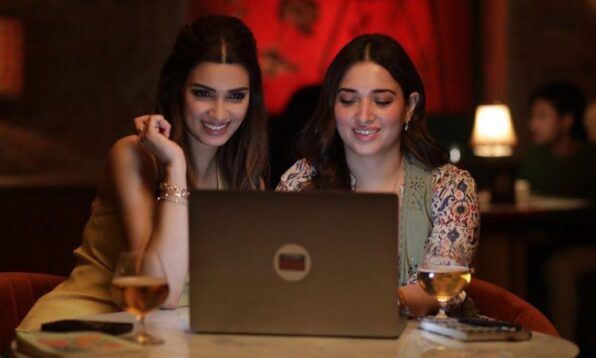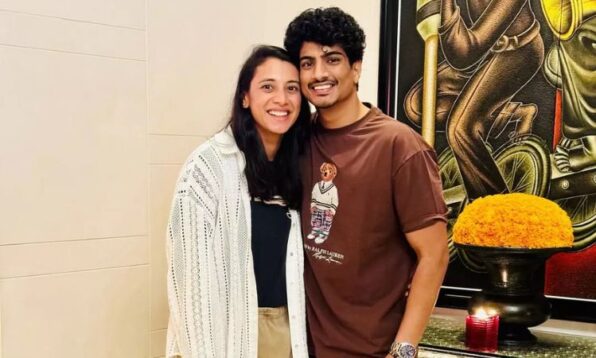We know that gender inequality in India doesn’t just exist, it thrives. Women literally pay the price of being a woman in this country. Every month, we spend hundreds, maybe thousands, on things men don’t even have to think about. We pay more to feel safe, more to get a haircut, more for everyday products made “especially for women”. We don’t just pay bills, we pay a hidden tax for simply existing in a world that favours men. Women earn less than men for the same jobs, but have to pay more to just live.
Periods and pink tax: Femininity isn’t a luxury
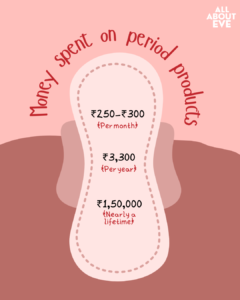
Let’s start with the one thing no woman can avoid: periods. Every month, women spend around ₹250-₹300 on pads or tampons. Sounds harmless? Stretch it across a year and it’s ₹3,300. Across a lifetime? Nearly ₹1.5 lakh. And that’s without counting the painkillers many need. The kicker? Men don’t spend a single rupee on this biological reality.
But the bleeding bill isn’t where it ends. The moment you exit the pharmacy and enter the supermarket to buy other everyday essentials, you run into another price tag — the infamous pink tax. In case you’re new to the term, it’s when identical products cost more simply because they’re marketed to women. A study by the New York City government, titled “From Cradle To Cane: The Cost of Being a Female Consumer”, found that 30 out of 35 products analysed were more expensive for women, with general items priced seven per cent higher and personal items 13 per cent higher. This study holds true for India as well. Here’s an example. One razor costs women ₹99, while one razor costs men only ₹19. That’s ₹80 less. And this kind of disparity exists in all products and services.

Men walk out of a salon with a good haircut for ₹200, while a basic trim for women will cost you ₹350 and upwards. Go a little fancy and the prices will skyrocket. And this isn’t luxury. This is the price of looking “presentable” in a society that judges women harsher than men if they don’t. This tax isn’t on beauty, but on femininity itself. So, the next time someone tries to tell you gender inequality in India doesn’t exist or is shrinking, show them these numbers.
The safety tax of being a woman
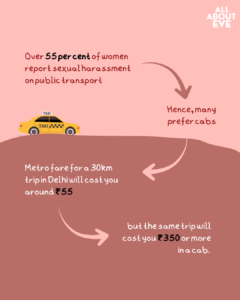
Safety is another bill only women have to pay. Over 55 per cent of women report sexual harassment on public transport. That explains why so many ditch buses and trains altogether and take cabs. Metro fare for a 30km trip in Delhi will cost you around ₹54, but the same trip will cost you ₹350 or more in a cab, depending on multiple factors. An online survey’s findings in 2019 showed while the average length of a woman’s trip is 37.5 per cent less than a man, it costs 35 per cent more than that of a man. Why? Because women choose door-to-door options to feel safe or to rush back home to their unpaid work (more on that later). If you’re a woman, reading this, congratulations, you are spending nearly 10 per cent of your salary on transportation. Men, on the other hand, are not. They book cabs because they want to, not because they have to.
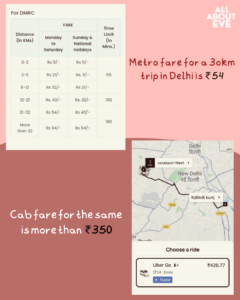
But travel isn’t the only thing women are paying more for to feel safe. Women-only hostels cost about 7.8 per cent more than co-ed ones. Safety wins every time, even if it empties your wallet. Men can gamble with shady areas. Women can’t.
Worrying about their safety also has health repercussions for women. A recent Harvard study shows that women stalked by men are 41 per cent more prone to heart disease. This means you might still be paying for cardiovascular issues even after doing your best to maintain a physically healthy life. In terms of mental health, too, women spend way more than men. A survey by ekincare, a digital health platform, found that women are three times more likely to seek therapy than their male counterparts. And therapy costs quite a lot in India, around ₹1,000–₹2,000 per session.
Women bear the onus of sexual health
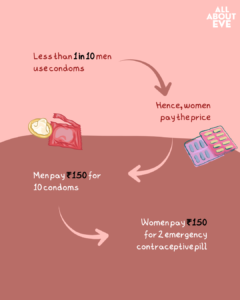
Most of us assume that when it comes to sexual health, men take up the responsibility because we believe condoms are the most used method of contraception in India. However, it turns out the assumption is wrong and hugely so. Female sterilisation, not condoms, is the most prevalent method of contraception in India. Fewer than one in 10 men use condoms in India, which adds up to only 9.5 per cent of Indian men using condoms. Female sterilisation stands at 37.9 per cent, despite costing ₹20,000-₹50,000, depending on the city. Condoms, however, are quite cheap. You can easily get a pack of 10 condoms for ₹100-₹150, while emergency contraceptive pills for women cost ₹100-₹200 for just two pills. So, the burden of family planning rests on women’s wallets, bodies, and health. Because all kinds of birth control pills mess with their hormones, leading to visits to the gynaecologist that cost around ₹500-₹1,500 for each visit.
And those visits aren’t rare. More than 58 per cent of Indian women are anaemic and 21 per cent are malnourished. These are the two biggest health issues Indian women face. But lately, Indian women have found themselves in the midst of another fast-growing health crisis: PCOS. According to the National Library of Medicine, one in five women in India is struggling with PCOS.
A woman earns ₹40 for every ₹100 a man earns
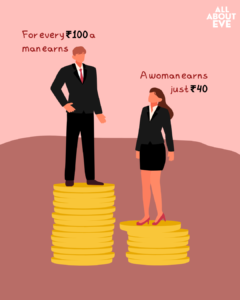
Even after paying so much more for basics, women earn less than men. This is one of the most significant markers of gender inequality in India because the numbers laugh in our faces. For every ₹100 a man earns, a woman earns just ₹40. Female workforce participation in 2024 was 32.8 per cent, compared to men at 77 per cent. Yes, more companies boast about hiring women freshers, but only 10 per cent make it into senior leadership. Career breaks for childcare or family aren’t “choices” either — they’re inevitabilities. And getting back into the workplace after a break of a couple of years often means upskilling. Yes, men have to upskill too, but they learn it on the job, spending a part of what they are earning to learn, while women spend out of their pocket to prove they’re still employable.
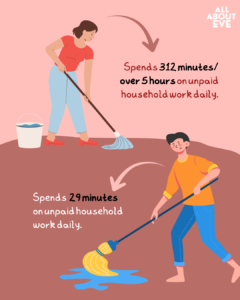
When women step back into their homes, they don’t get to rest — they clock into their unpaid second jobs. On average, urban Indian women spend 312 minutes (over 5 hours) on unpaid household work daily. Men? 29 minutes. Oxfam estimated that if women were paid for this work, it would add 3.1 per cent to India’s GDP. Shruti Deora, founder of Abhiyaan Wealth, even calculated that if a homemaker in a Tier-1 city like Delhi were paid fairly, she’d earn ₹5.4 lakh a month. Even when women aren’t stay-at-home moms, they are the ones doing most household tasks.
What’s the price of being a woman?
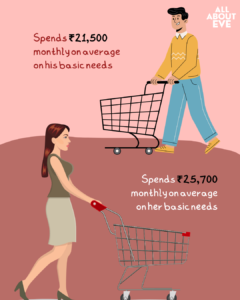
When we add this all up, the difference is staggering. If a man spends ₹21,500 monthly on average on his basic needs, a woman spends nearly ₹4,200 (nearly 20 per cent) more on her basic needs. Add to this the cost of therapy and contraceptives that women have to bear as a result of existing in a patriarchal world.
And just when you think the bill couldn’t get any longer, reality serves a cruel twist: the more the media reports sexual assaults, the fewer women are seen in the workforce. Let that sink in. Not only are women forced to spend far more than men just to exist, but crimes against them are literally pushing them out of jobs. First, women are overcharged. Then, they’re underpaid or not paid at all.
If women earn less, spend more, and are charged extra at every turn, from healthcare to safety to basic survival, then how can we still pretend that equality is anything more than a myth? When simply existing demands not just emotional and physical but also financial tolls, the playing field is not level.
Related: Alimony Law In India: What You Need To Know About Rights, Rules, And Protecting Your Wealth

 Web Stories
Web Stories








